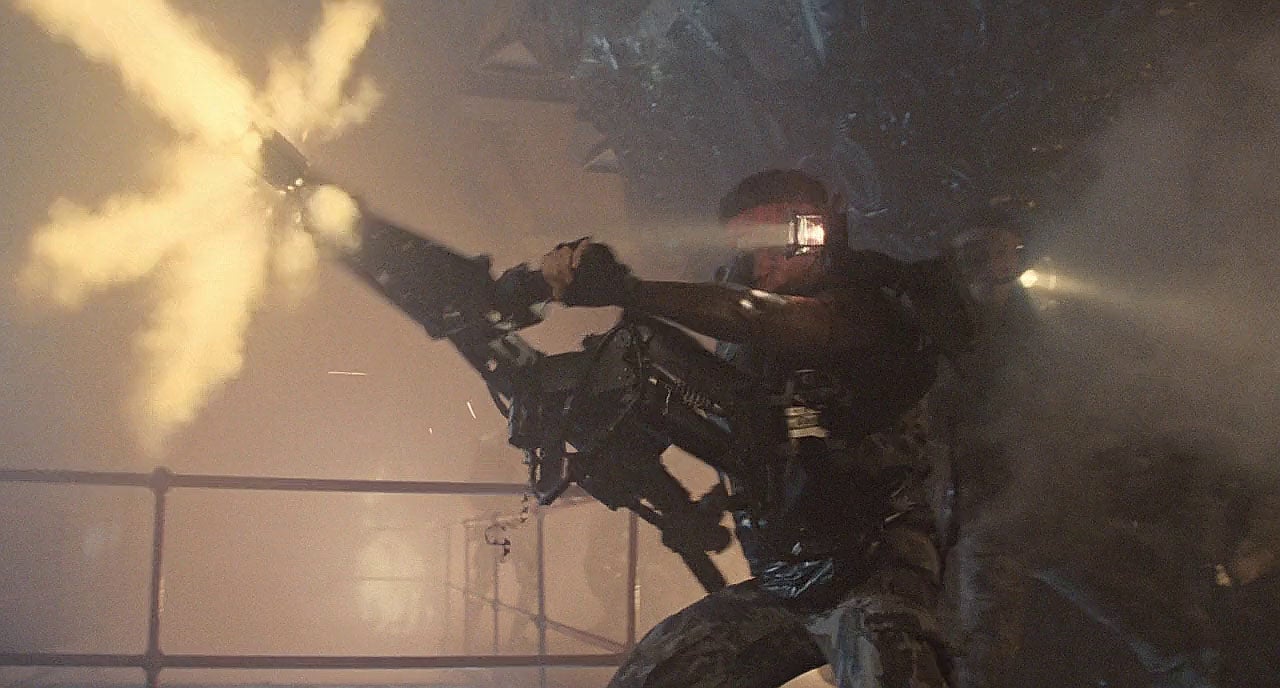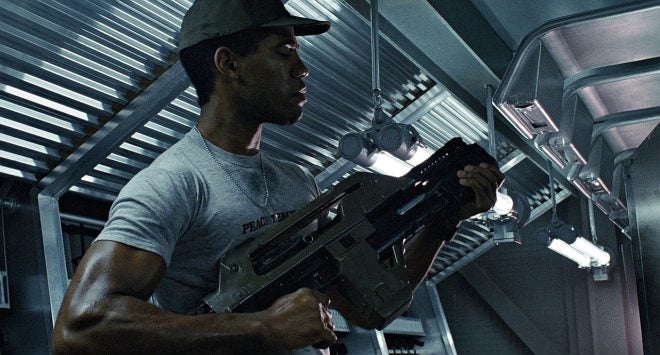With the recent announcement of a new US Space Force, everyone on the Internet has been talking about being first in line to the recruiter’s office to become one of the country’s first Space Marines (we have seen enough movies to know it is only a matter of time). But once you’ve signed up, what will you be issued as your primary weapon? Let’s take a not-entirely-serious look at weapons from real life, film, and fiction that could inspire those issued to future US Space Marines!
TFB EDITORIAL: Top 5 Guns for Future US Space Marines
5. The FN P90
“This… Is a weapon of war. It’s made to kill your enemy.”
As seen in: Stargate SG-1

Christopher Judge’s character Teal’c demonstrates the best way to handle P90s in the 9th season of Stargate SG-1. Screenshot credit: IMFDB.org.
Besides looking like it comes from the future, the real-life P90 combines a number of characteristics that would be legitimately desirable for future extraterrestrial military operations. First, its compact size, automatic fire rate, and high magazine capacity make it highly suitable for use in confined spaces, such as on a space station or moon base. In addition, the P90’s ammunition is half the weight of the 5.56x45mm round used by most modern assault rifles, meaning that twice as much ammunition can be lofted into orbit per rocket – an important consideration when going from the Earth into outer space. The weapon’s low recoil would also minimize disturbances to the shooter when firing in low- or null-gravity, giving it another advantage against more powerful weapons. The P90’s biggest drawbacks are also significantly mitigated in space: The relatively short range of its ammunition is not a concern, as fighting would be conducted either in environments without an atmosphere which would slow down the bullet, or in the claustrophobic confines of a space station or extraterrestrial base. Likewise, the low power of the P90’s ammunition is much less of a penalty when shooting at spacesuit-clad foes, as even one hole in a normally nonlethal zone could effectively take the target out of the fight. And hey, if it’s good enough for SG-1…
4. The H&K G11
“I love this gun!”
As seen in: Demolition Man

Wesley Snipes’ character Simon Phoenix points the “Magnetic Accelerator” during the museum fight scene in Demolition Man. Screenshot credit: IMFDB.org.
The P90 may have lightweight ammo, but thanks to its caseless technology the German G11 assault rifle’s ammunition is just as small and even lighter – all the while bringing the performance of a true intermediate rifle cartridge to the table. Packing a punch roughly equivalent to a Russian 5.45mm assault rifle cartridge, the G11’s 4.7x33mm round only weighs 80% that of the P90’s diminutive ammo, and only 44% as much as the 5.56x45mm NATO round. Certainly, the G11 looks the part of a “space gun”, too. Its blocky, compact appearance made it the choice to play the “Magnetic Accelerator” gun in the 1993 film Demolition Man. Though the G11 itself was not mature or affordable enough to see real-world service, its caseless ammunition technology could one day be applied to future small arms – perhaps, even ones used in outer space.
3. C-14 Gauss Rifle
“You want a piece of me, boy?”
As seen in: StarCraft

Terran Marines stand triumphant around piles of ludicrously oversized brass shell casings in the Starcraft: Remastered Terran victory screen. Their equally comic-looking C-14 Gauss Rifles incorporate a unique weapon concept. Screenshot credit: Reddit.com.
If the world is ready for Space Marines, then Space Marine powered armor is sure to follow close behind. And if you’ve got a power source that makes powered armor practical, why not create a ludicrously powerful electromagnetically-assisted machine gun to go with it? Buried deep within the lore of the real-time strategy game StarCraft is the description of the C-14 Gauss Rifle used by the Terran Marines, the most basic units of the game’s human faction:
In use by 2478, the C-14 usually fires hypersonic 8 mm armor-piercing metal “spikes” which can penetrate up to two inches of steel plating. The rounds themselves are encased in steel. While the rifle is gauss-assisted, it still utilizes traditional means to firing projectiles such as gunpowder, which is known to cause issues with the rifle when the ammunition becomes wet. The magnetic induction that gives the gauss rifle its name is achieved via a magnetic accelerator pack within the gun.
The Impaler is fully automatic with a fire rate of 30 rounds per second, although fully automatic fire is discouraged under most circumstances. A capacitor system is used to fire the weapon in short bursts, conserving ammunition and minimizing power requirements. Due to this, the C-14 rifle has high recoil; CMC armor is designed to suppress this. The armor can also supplement the rifle’s power supply.
Setting aside the game’s over-the-top tone, the idea of an electromagnetically assisted but otherwise conventional firearm is an uncommon, but pretty interesting one. The StarCraft Wiki’s text above describes the C-14 as firing 8mm rounds at “hypersonic” speeds – hypersonic being generally accepted as Mach 5 (5,625 ft/s at sea level) and above. Coincidentally, 5,500 ft/s is close to the velocity ceiling for modern solid propellants, meaning that a real-life hypersonic rifle would likely need some sort of assist, which could be electrochemical in theory, to reach true hypersonic speeds. Gauss guns themselves are well-proven, but require tremendously heavy batteries even with relatively unimpressive muzzle velocities. For example, this 7.75lb homemade Gauss gun stores 1,250 J in its capacitors, or less than that stored in a single round of 5.56mm ammunition! Therefore, in order for any significant Gauss assist to be practical, power densities would have to be much higher than they are today – but the same is pretty much true for power armor, too!
The rounds fired by the C-14 are described as being 8mm caliber, and made of depleted uranium. Guesstimating based on the penetrator in the A-10 Warthog’s 30mm PGU-14/B round, this implies a bullet weight of about 450 grains (!), fired at probably between 6,500 and 10,000 ft/s – meaning each round has a muzzle energy of between 57,000 and 135,000 Joules! Further, assuming maximum performance from the conventional propellant, the electrical power source for the C-14’s Gauss assist would need to provide between 480,000 and 2.82 million Watts of power! Whew! I guess we won’t be seeing Gauss-assisted small arms for a while!
2. Recoilless Guns
“Oy, papa, look like nobody home maybe?”
As seen in: The Expanse

Protagonist James Holden (Steven Strait) using a “recoilless pistol” in The Expanse television show. The tube along the top suggests the weapon works like a recoilless rifle… Although that would imply Holden is in for a healthy dose of backblast to the face if he pulls the trigger. Screenshot credit: IMFDB.org.
Newtonian physics tells us that for every action, there is an equal and opposite reaction. Thanks to ol’ Isaac, shooting a firearm in null-g presents a bit of an issue: How do you keep the gun’s recoil from pushing you around, and off target, while you’re shooting at whatever needs shot at? Although not technically detailed in the books or television show, the authors of The Expanse suggested a solution: Recoilless rifles! The weapons in The Expanse are a bit of an enigma – the novels describe specialized weapons that fire recoilless ammunition, while the material in the TV show suggests that there are weapons capable of firing both conventional rounds, and recoilless rounds when “on the float”. The guns are first described in Chapter Three of Leviathan Wakes:
Holden used his officer’s key to open the weapon locker, and Amos took a high-caliber automatic that fired self-propelled rounds, recoilless and designed for use in zero g. Old-fashioned slug throwers were more reliable, but in null gravity they were also maneuvering thrusters. A traditional handgun would impart enough thrust to achieve escape velocity from a rock the size of CA-2216862.
There are two possible ways to create an effectively recoilless small arm. First, like the large-caliber recoilless rifles that exist today, the weapon could have a vent towards the rear that expelled propellant gases through both the muzzle and aft of the gun, effectively cancelling recoil. The second is to make the projectile self-propelled, like a rocket. Specialized ammunition of this type was fired by the curious 1960s-era Gyrojet family of weapons. Recently, YouTuber Taufledermaus got the extremely special opportunity to test fire both a Gyrojet pistol and carbine, whose highly collectible ammunition today runs nearly $100 a shot!
Both recoilless concepts present serious design challenges to the small arms engineer, such as how to direct backblast away from the shooter’s face, and how to eliminate the minimum range of the slowly-accelerating Gyrojet-type projectiles. But who knows, maybe one day, Space Marines will enjoy maximum zero-g accuracy with completely recoilless weapons firing one or both of these kinds of ammunition!
1. M56 Smart Gun
“LETS ROCK!”
As seen in: Aliens

Private Vasquez (Jenette Goldstein) opens up with her M56 Smart Gun in James Cameron’s classic action thriller, Aliens. Screenshot credit: IMFDB.org.
The 1986 James Cameron film Aliens brought realistic future soldiers and military equipment to the big screen, and perhaps the most prophetic piece of kit in the film was the M56 Smart Gun. Essentially a machine gun equipped with a Steadicam-style stabilized rig and smart networked optics, the M56 represents an idea so promising yet down-to-earth that the US Army Research Lab (ARL) thinks it might just be the way of the future. Early prototypes of a gun-stabilizing “third arm” much like that on the fictional M56 have received positive initial reviews from testers at the ARL, and the Army is continuing to test improved versions. TFB’s own Nicholas C even tested a homemade third arm, and came back impressed with the concept. If the arm can be made light and rugged enough, third arms could start showing up in military service sooner than we think. Networked smart optics, like those depicted on the M56 in Aliens, are already a priority within the Army’s ambitious NGSAR program – which means it might not be long before US Space Marines are cutting down swaths of gigeresque extraterrestrials with their very own real-life Smart Guns!
Now that you’ve read through my choices, what kinds of guns do you think the Space Marines of the inevitable grimdark future will use? Let us know in the comments!
 Your Privacy Choices
Your Privacy Choices